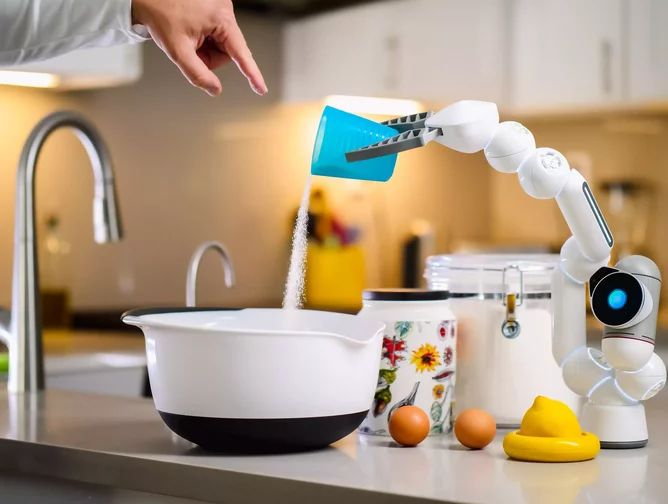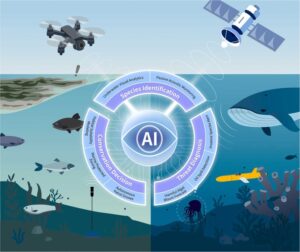The AI-Powered Home: A Deep Dive into the Latest Smart Appliances News and Innovations
For years, the promise of the “smart home” has been tantalizingly close, often defined by the ability to turn on a light or start a coffee maker with a voice command. While convenient, this first wave of connectivity was merely the foundation. Today, we are witnessing a profound transformation, a leap from simple remote control to genuine intelligence. The latest Smart Appliances News reveals a market saturated with devices powered by sophisticated artificial intelligence, machine learning, and advanced sensor fusion. These are not just connected appliances; they are cognitive partners designed to learn, adapt, and anticipate our needs, creating a home environment that is more efficient, personalized, and seamlessly integrated than ever before. This evolution marks a pivotal moment in consumer technology, shifting the focus from reactive commands to proactive assistance, and turning the abstract concept of an automated home into a tangible, everyday reality.
The New Wave of Intelligence: Key Trends Shaping the Modern Smart Home
The latest advancements showcased in the tech world signal a clear departure from single-function smart gadgets. The emerging trend is a holistic, AI-driven ecosystem where appliances communicate not just with the user, but with each other, to optimize the entire home environment. This new paradigm is built on three core pillars: cognitive automation, hyper-personalization, and a foundational focus on sustainability.
From Connectivity to Cognition: The AI Revolution in the Kitchen
The kitchen has become the central hub for this AI revolution. The most exciting AI Kitchen Gadgets News centers on appliances that think. For instance, new-generation smart ovens are equipped with internal cameras and sophisticated computer vision algorithms. This isn’t just for checking on your food from your phone; this is a core part of the cooking process. The oven’s AI can identify the dish you’ve placed inside—be it a roast chicken or a tray of cookies—and automatically suggest the ideal cooking mode, temperature, and time. It then monitors the food in real-time, adjusting heat distribution to ensure an even bake and sending an alert when it reaches perfection. Similarly, smart refrigerators now use internal scanners to track inventory, recognize expiring items to reduce food waste, and even suggest recipes based on the ingredients you have on hand, integrating seamlessly with meal-planning apps on your AI Phone & Mobile Devices News-worthy smartphone.
Hyper-Personalization and Proactive Assistance
The true power of modern smart appliances lies in their ability to learn individual and family routines. This goes far beyond pre-set schedules. A smart washing machine, leveraging a suite of internal sensors, can detect the specific fabric types, load weight, and soil level of a laundry batch. It then uses this data to create a custom wash cycle, optimizing water usage, detergent amount, and energy consumption for that specific load. This level of personalization extends throughout the home. Imagine a scenario where your AI Fitness Devices News tracker notes you’ve completed a strenuous workout. It communicates with your smart home hub, which then prompts your AI-powered blender to suggest a post-workout protein smoothie, tailored to your specific dietary needs and preferences. This is the essence of proactive assistance—the home anticipating your needs before you even articulate them.
Sustainability and Efficiency as Core Features
With growing environmental awareness, energy efficiency has become a primary driver of innovation. The latest AI for Energy / Utilities Gadgets News highlights how smart appliances are becoming key players in home energy management. A smart dishwasher can analyze your local utility’s pricing data and automatically schedule its cycle to run during off-peak hours when electricity is cheapest. Smart HVAC systems and thermostats learn your family’s movement patterns, ensuring rooms are comfortable when occupied and conserving energy when empty. This data-driven approach not only lowers utility bills for the consumer but also contributes to a more stable and efficient energy grid, a core concept in the broader vision of Smart City / Infrastructure AI Gadgets News.

Under the Hood: The Technology Powering the Next Generation of Smart Appliances
The remarkable capabilities of today’s smart appliances are not magic; they are the result of converging advancements in several key technological fields. Understanding this underlying tech stack is crucial to appreciating the depth of the current innovation cycle and where the industry is headed.
The Role of On-Device AI and Edge Computing
A significant trend highlighted in recent AI Edge Devices News is the shift from cloud-based processing to on-device, or “edge,” AI. Early smart devices relied heavily on sending data to a remote server for analysis, which introduced latency and significant privacy concerns. Modern appliances increasingly use powerful, dedicated AI chips to perform complex calculations locally. For example, a smart security camera featuring person and package detection no longer needs to stream video to the cloud for analysis. The recognition happens directly on the device. This principle is now being applied in appliances. An oven with AI-enabled Cameras & Vision News can identify food types without an internet connection, ensuring faster response times and keeping sensitive data about your household’s eating habits within your home. This enhances both performance and user trust.
Advanced Sensor Fusion and Computer Vision
The intelligence of a smart appliance is directly proportional to the quality and variety of data it can collect. This is where advanced sensor fusion comes into play. A state-of-the-art Robotics Vacuum News device is a prime example. It doesn’t just use a single laser for navigation; it combines data from LiDAR, 3D cameras, infrared sensors, and ultrasonic sensors to build a hyper-accurate map of its environment. This fusion allows it to not only avoid stairs but also to differentiate between a sock and a solid obstacle, or even identify and steer clear of pet waste—a common pain point addressed by the latest AI Pet Tech News. This multi-sensory approach, governed by a central AI, allows for a much more nuanced and reliable interaction with the real world.
The Rise of Generative AI and Natural Language Interfaces
Voice control is evolving rapidly thanks to breakthroughs in large language models (LLMs), the same technology behind generative AI. The latest AI Assistants News shows a move away from rigid, command-based interactions. Instead of saying, “Preheat oven to 400 degrees Fahrenheit,” a user might soon be able to have a conversation: “I want to bake a sourdough loaf, but I’m new to this. Can you help?” The appliance’s integrated assistant could then walk the user through the entire process, asking clarifying questions and automatically setting the complex series of temperature and humidity changes required for a perfect crust. This conversational intelligence, often delivered through high-fidelity speakers discussed in AI Audio / Speakers News, makes technology more accessible and intuitive for everyone.
The Integrated Ecosystem: How Smart Appliances are Creating a Cohesive Home
The ultimate vision for the smart home is not a collection of clever gadgets but a single, cohesive entity that functions as a seamless extension of its inhabitants. This requires a level of integration and interoperability that has, until recently, been a major industry challenge. Now, new standards and a focus on cross-platform communication are making this vision a reality.
Interoperability and a Unified Smart Home

For years, the smart home was fragmented into “walled gardens” controlled by major tech companies. An appliance from one brand couldn’t easily communicate with a sensor from another. The emergence of universal standards like Matter is changing the game. Matter provides a common language for smart home devices to communicate over local networks, regardless of the manufacturer. This unlocks powerful, real-world automation scenarios. For example, a Matter-certified smart smoke detector, a key piece of AI Monitoring Devices News, can detect a kitchen fire and instantly trigger a network-wide response: it tells the smart oven to cut power, signals the AI Lighting Gadgets News system to flash all lights red, instructs the smart blinds to open for an easy exit, and broadcasts a warning through every smart speaker in the house. This level of automated, life-saving coordination is the true promise of an integrated ecosystem.
Connecting Health, Wellness, and the Kitchen
One of the most compelling frontiers is the convergence of smart appliances with personal health and wellness technology. The latest Health & BioAI Gadgets News points to a future where your home actively participates in your health journey. Imagine your wearable device, a source of Wearables News, shares data about your sleep quality and daily activity levels with your smart home. If it detects a poor night’s sleep, your AI Sleep / Wellness Gadgets News-integrated coffee machine might suggest a less intense brew to avoid jitters. After a workout, your smart scale and fitness tracker data could be sent to your smart refrigerator, which then highlights ingredients for a recovery-focused meal. This creates a powerful feedback loop where your environment intelligently supports your health goals.
The Future of Home Automation: From Smart to Predictive
As these systems gather more data and their AI models become more sophisticated, the home will transition from being automated to being truly predictive. This is the domain of ambient computing, where technology fades into the background and simply works. Drawing parallels from Autonomous Vehicles News, where cars anticipate road conditions, your home will anticipate your needs. Your car might signal that you are ten minutes away from home, triggering a “welcome” sequence: the thermostat adjusts to your preferred temperature, the entryway lights turn on, your favorite playlist begins to play softly, and the oven starts preheating for the dinner you planned earlier. This predictive capability, powered by a network of AI Sensors & IoT News, is the end goal—a home that doesn’t just respond to you, but takes care of you.
Practical Considerations for the AI-Powered Home
While the future of the AI-powered home is exciting, adopting this new technology requires careful consideration. Consumers must balance the benefits of convenience and efficiency against potential challenges like cost, privacy, and security. Making informed decisions is key to building a smart home that is both helpful and secure.

Navigating the Challenges: Privacy, Security, and Cost
The primary concern for many consumers is privacy. By their very nature, smart appliances collect vast amounts of data about your daily life—what you eat, when you do laundry, who visits your home. This makes robust security essential. Any internet-connected device is a potential target for cyberattacks, making the news around AI Security Gadgets News particularly relevant. Consumers must scrutinize the privacy policies of manufacturers and prioritize brands that offer end-to-end encryption and clear data control options. Furthermore, the initial cost of these advanced, AI-equipped appliances can be significantly higher than their non-smart counterparts, creating a barrier to entry for many households.
Best Practices for Consumers
For those ready to invest, a strategic approach can maximize benefits and minimize risks:
- Prioritize Ecosystem Compatibility: Look for devices that support universal standards like Matter. This ensures your new appliance will work with your existing devices and won’t lock you into a single brand’s ecosystem.
- Evaluate the “Smart” Features: Critically assess whether the AI-driven features solve a real problem for you. Is an AI-powered camera in your oven a useful tool for your cooking style, or is it an unnecessary gimmick? Focus on utility over novelty.
- Start Small and Scale Up: You don’t need to replace every appliance at once. Begin with one or two high-impact devices that offer immediate value, such as a top-tier robotics vacuum or a smart thermostat. This allows you to learn the technology and expand your ecosystem thoughtfully over time.
- Secure Your Network: The foundation of a secure smart home is a secure home network. Use a strong, unique password for your Wi-Fi, enable WPA3 encryption if available, and keep your router’s firmware updated.
Conclusion: The Dawn of the Truly Intelligent Home
The latest wave of smart appliance innovation signals a definitive shift from a novelty-driven market to one focused on delivering tangible value through artificial intelligence. We are moving beyond simple connectivity and into an era of cognitive, predictive, and deeply integrated home ecosystems. The trends in Smart Home AI News clearly show that the focus is now on creating appliances that learn our habits, anticipate our needs, and operate with a degree of autonomy that enhances our daily lives, improves efficiency, and even supports our health and wellness goals. While challenges around cost, security, and privacy remain, the technological foundation is now firmly in place. The smart home is no longer a futuristic concept; it is an evolving reality, and its intelligence is just beginning to awaken.










